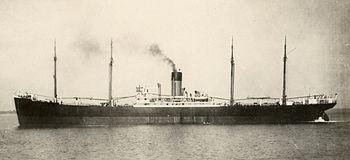SS Alster (1928)

SS Alster in 1929
|
|
| History | |
|---|---|
| Name: |
|
| Namesake: | Alster, a tributary of the river Elbe in Germany |
| Owner: |
|
| Operator: |
|
| Port of registry: | |
| Route: | Germany - Australia (1928–40) |
| Builder: | Deschimag Werk Vulcan, Hamburg |
| Yard number: | 211 |
| Launched: | 5 January 1928 |
| Completed: | 25 February 1928 |
| Out of service: | 20 April 1941 |
| Identification: | |
| Fate: | Torpedoed and sunk |
| General characteristics | |
| Class and type: | Cargo liner |
| Tonnage: | |
| Length: | 509.9 ft (155.42 m) |
| Beam: | 63.6 ft (19.39 m) |
| Depth: | 30.9 ft (9.42 m) |
| Installed power: | 6,500 ihp (4,800 kW) |
| Propulsion: | Triple expansion steam engine, 1 low pressure steam turbine |
| Speed: | 14 knots (26 km/h) |
| Crew: |
|
Empire Endurance was a 8,514 GRT cargo liner that was built in 1928 as Alster by Deschimag Werk Vulkan, Hamburg, Germany for the shipping company Norddeutscher Lloyd. In the years leading up to the Second World War Alster carried cargo and passengers between Germany and Australia. After the outbreak of war she was requisitioned by the Kriegsmarine for use as a supply ship.
Alster was captured off Norway on 10 April 1940 by the British destroyer HMS Icarus. Initially serving under the original name as a repair, supply and cargo ship in Norway, she was later passed to the Ministry of War Transport (MoWT) and renamed Empire Endurance. She served until 20 April 1941 when she was torpedoed and sunk by the German submarine U-73 south-east of the islet of Rockall in the North Atlantic Ocean.
The ship was a 8,514 GRT cargo liner. She was built in 1928 by Deschimag Werk Vulkan, Hamburg as Alster, with yard number 211.
Alster was 509.9 feet (155.42 m) long, with a beam of 63.6 feet (19.39 m). She had a depth of 30.9 feet (9.42 m). She was assessed at 8,514 GRT, 5,328 NRT, 12,000 DWT. She had four masts, a single funnel, a round stern and a slanted stem.
...
Wikipedia
